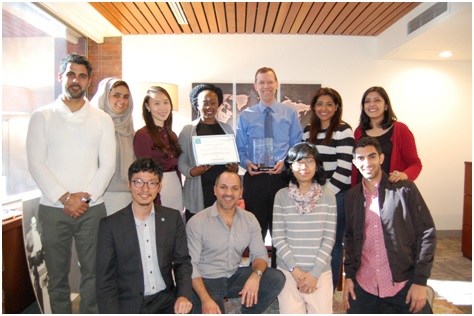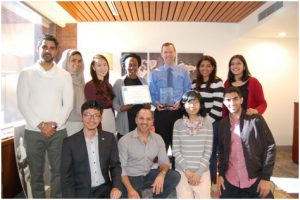With HKS Dean Doug Elmendorf after receiving the Global Universities Challenge Award. Photo Credit: hks.harvard.edu
By Andhyta F. Utami, MPP 2018
It is mind-blowing to think that our grandparents used to wait for weeks before they got to hear from a distant relative through a short postcard message. Today, I can video call with my entire family (10,000 miles away in Indonesia) every day. It is also mind-blowing to think that we used to carry around floppy disks that contained barely 1.44 megabytes of data. Meanwhile, now I store terabytes of information on the cloud. Indeed, humankind has changed the way that it communicates, transports, and operates more in the past decade than in the past century combined.
And yet, there’s one institution invented by humans that has hardly changed: government. Defining government as a tax-collecting institution that conducts public works and owns a standing army, the oldest written records we have of such an institution is from Mesopotamia in 5000-3500 BC. While many state agencies have adopted advanced technologies to deliver services swifter and more effectively, the core approach in how we govern remains the same. Government is still a tax-collecting institution that conducts public works and owns a standing army. In the past centuries, it has continued to face the same challenges: governments in some countries remain corrupt, stay in siloes, and are generally inefficient. Is there anything they could have done differently?
Last February, I was selected as part of a group to represent HKS at the World Government Summit Global Universities Challenge. We were asked one simple question: What does the future of government look like? Despite having barely 8 hours to come up with an idea, we managed to win first place against 12 other groups from universities in six countries, including LSE, IESE, UCL, Stanford, and MIT. Our seven-minute pitch was judged by, among others, Silicon Valley entrepreneur Chris Schroeder and Ideo Chief Creative Officer Paul Bennett. The judging criteria were: novelty, innovation, impact, comprehensiveness, and feasibility. The Challenge was part of a larger World Government Summit conference, where leaders of major international institutions—such as the IMF, World Bank, World Economic Forum, UN Secretary-General, and UNFCCC—were present. The event was attended by over 4,000 delegates and 150 speakers from 140 countries.
So, what does the future of government look like? While the possibilities are endless, we zeroed in on the challenge of automation. The same way the second industrial revolution replaced most laborers with machines, we think that perfected artificial intelligence and automation would affect even the most sophisticated jobs today, from drivers to lawyers. The rate of unemployment will skyrocket. Beyond welfare concerns, many people will lose their sense of purpose. Social unrests may escalate.
Our idea was to introduce a “cit-coin,” or a “citizen-government currency” through which ordinary citizens can be involved in the workings of the government and help drive solution-oriented actions. Cit-coin will break the citizen-government dichotomy and jumpstart the transition from traditional government agencies to a more inclusive governance where citizens participate in fuller roles to contribute to society. Citizens can assess social issues around them and implement various programs, incentivized and compensated through “citizen government coins.” Cit-coins could either be cashable or usable in health and education access. More than a universal basic income, cit-coins bring a new sense of purpose to the people—it encourages activities of, by, and for the people.
While this idea is not perfect, I am glad to have started the conversation with fellow MPP, MPA/ID, and MC/MPA students about the future of government. Indeed, as a community at HKS, this is a major challenge we should spend more time thinking about. Beyond foreseeable challenges, we need entrepreneurial minds that can examine the possibilities 20, 30 years from now.
During his keynote speech at the 2016 World Government Summit, Obama noted that “government exists for one reason: to serve our people, to help improve their lives.” The question now is: How can the government do that while keeping up with rapid technological changes?

